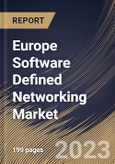The rising investments by various telecom service providers in 5G infrastructure would help to improve connectivity and maximize the deployment of SDN solutions. Also, the evolution of the 5G infrastructure network would help boost the market's growth. Also, the enterprise's propensity toward digitalization further propels the demand for robust network services. Many companies want to enhance their network capabilities, where software defined network is gaining traction. For instance, in February 2023, ETSI Open-Source Group TeraFlowSDN declared the 2nd launch of TeraFlowSDN controller, a robust and innovative SDN controller and orchestrator. TeraFlowSDN Release 2 delivers validated and extended support for slicing end-to-end transport networks over various domains.
The SDN is the increasing demand for network virtualization. Organizations seek ways to decouple network functions from traditional hardware, enabling them to create virtualized networks that are more adaptable to changing business needs. SDN allows for the abstraction of network functions, making managing and deploying virtual networks easier. The proliferation of cloud computing has been a catalyst for SDN adoption. Cloud environments require dynamic and scalable networks, and SDN provides the flexibility needed to adapt to the demands of cloud-based services. The ability to supervise and configure network resources on-demand aligns well with the dynamic nature of cloud infrastructure.
European businesses across various industries are actively pursuing digital transformation initiatives. According to the International Trade Administration (ITA), in 2022, the total revenue generated by the various IT subsectors in Germany was USD 34.1 billion for software, USD 45.3 billion for services, and USD 34.9 billion for IT hardware. The IT industry has witnessed substantial growth in total revenue since 2007, escalating from USD 76.4 billion to an expected USD 114.3 billion by 2021. A trend of consistent expansion has become apparent in recent times. As opposed to 102.6 billion EUR in 2021, total revenue is expected to reach 108.6 billion EUR in 2022. Due to the aforementioned factors the market growth will drive in this region.
The Germany market dominated the Europe Software Defined Networking Market by Country in 2022 and would continue to be a dominant market till 2030; thereby, achieving a market value of $4,734.7 million by 2030. The UK market is exhibiting a CAGR of 15.8% during (2023 - 2030). Additionally, The France market would experience a CAGR of 17.6% during (2023 - 2030).
Based on Offering, the market is segmented into Software, SDN Infrastructure and Services. Based on Type, the market is segmented into Open SDN, SDN via Overlay, SDN via API, and Hybrid SDN. Based on Application, the market is segmented into SD-WAN, SD-LAN, Security Applications, and Others. Based on End-User, the market is segmented into Enterprises, Telecommunication Service Providers, and Cloud Service Providers. Based on Vertical, the market is segmented into BFSI, Government & Defense, Education, Healthcare & Lifesciences, Media & Entertainment, Manufacturing, Retail & eCommerce, ITeS and Others. Based on countries, the market is segmented into Germany, UK, France, Russia, Spain, Italy, and Rest of Europe.
The market research report covers the analysis of key stake holders of the market. Key companies profiled in the report include Cisco Systems Inc., Huawei Technologies Co., Ltd. (Huawei investment & Holding Co., Ltd.), VMware, Inc. (Broadcom Inc.), Dell Technologies, Inc. (Dell EMC), Juniper Networks, Inc., IBM Corporation, Ericsson AB, Ciena Corporation, Hewlett Packard enterprise Company and Nokia Corporation.
Scope of the Study
Market Segments Covered in the Report:
By Offering
- Software
- SDN Infrastructure
- Services
By Type
- Open SDN
- SDN via Overlay
- SDN via API
- Hybrid SDN
By Application
- SD-WAN
- SD-LAN
- Security Applications
- Others
By End-user
- Enterprises
- Telecommunication Service Providers
- Cloud Service Providers
By Vertical
- BFSI
- Government & Defense
- Education
- Healthcare & Lifesciences
- Media & Entertainment
- Manufacturing
- Retail & eCommerce
- ITeS
- Others
By Country
- Germany
- UK
- France
- Russia
- Spain
- Italy
- Rest of Europe
Key Market Players
List of Companies Profiled in the Report:
- Cisco Systems Inc.
- Huawei Technologies Co., Ltd. (Huawei investment & Holding Co., Ltd.)
- VMware, Inc. (Broadcom Inc.)
- Dell Technologies, Inc. (Dell EMC)
- Juniper Networks, Inc.
- IBM Corporation
- Ericsson AB
- Ciena Corporation
- Hewlett Packard enterprise Company
- Nokia Corporation
Unique Offerings
- Exhaustive coverage
- The highest number of Market tables and figures
- Subscription-based model available
- Guaranteed best price
- Assured post sales research support with 10% customization free
Table of Contents
Companies Mentioned
- Cisco Systems Inc.
- Huawei Technologies Co., Ltd. (Huawei investment & Holding Co., Ltd.)
- VMware, Inc. (Broadcom Inc.)
- Dell Technologies, Inc. (Dell EMC)
- Juniper Networks, Inc.
- IBM Corporation
- Ericsson AB
- Ciena Corporation
- Hewlett Packard enterprise Company
- Nokia Corporation








